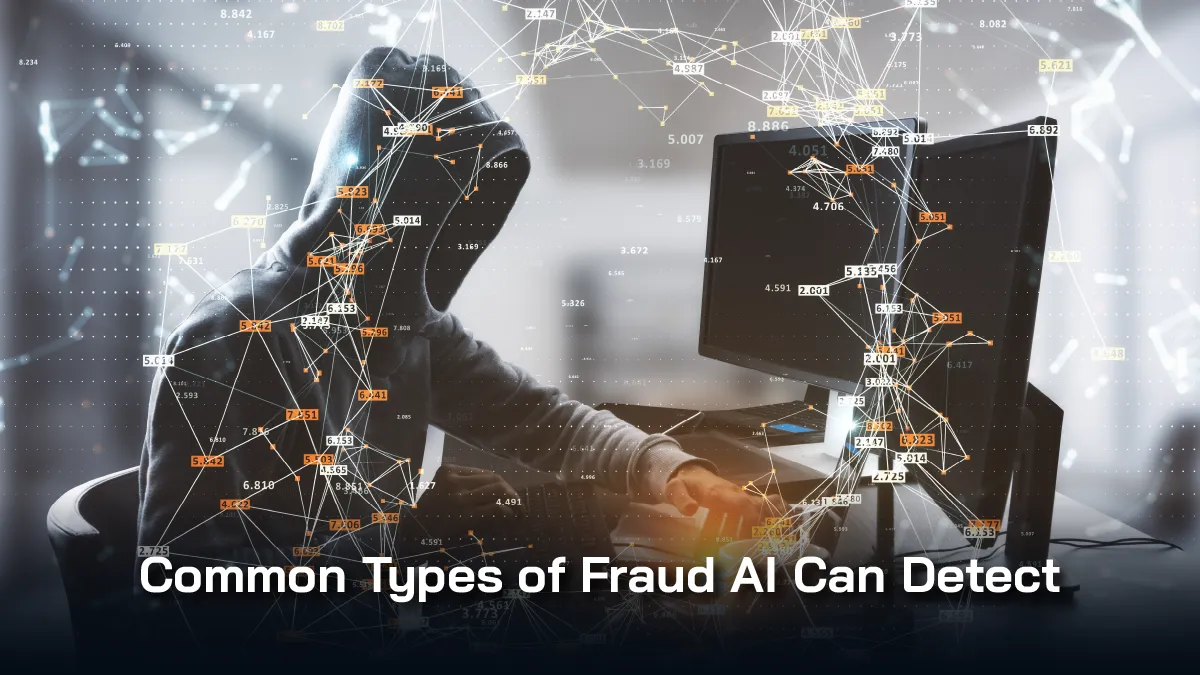Fraud is a growing concern for businesses across industries, with evolving tactics making it increasingly difficult to detect and prevent. Traditional methods of fraud detection often fall short of keeping up with the speed and sophistication of modern threats. Enter AI fraud detection—powerful tools that leverage machine learning and advanced algorithms to identify, mitigate, and prevent fraud in real time. By adopting AI technology, businesses can enhance security, reduce risks, and improve operational efficiency.
Let’s take a closer look at it in this comprehensive guide.
What is AI Fraud Detection?
AI fraud detection is a technology-based method that uses machine learning to find fraudulent activity in big datasets. In order to identify trends and irregularities that may indicate fraud, algorithms must be trained. Through constant learning from fresh data, these machine learning models get better over time, enhancing their forecast accuracy and allowing them to adjust to changing fraudulent strategies. This proactive defensive system gives companies a strong tool to preserve the security and integrity of transactions.
According to DigitalOcean’s 2023 Currents research, 37% of respondents raised their cybersecurity expenditures in order to purchase more sophisticated security software. One notable advancement in the battle against digital fraud is AI fraud detection.
How is AI Used in Fraud Detection?
 AI fraud detection relies on machine learning algorithms that analyze activities to spot anomalies indicating potential fraud. Initially, a baseline of normal user and transaction data is established. The system continuously monitors incoming data, identifying deviations from this baseline. As it encounters new data, the AI model refines its parameters, enhancing its ability to differentiate between fraudulent activities and legitimate actions.
AI fraud detection relies on machine learning algorithms that analyze activities to spot anomalies indicating potential fraud. Initially, a baseline of normal user and transaction data is established. The system continuously monitors incoming data, identifying deviations from this baseline. As it encounters new data, the AI model refines its parameters, enhancing its ability to differentiate between fraudulent activities and legitimate actions.
The mechanisms behind AI fraud detection include the following:
- Data gathering: Collecting extensive behavioral and transactional data from various sources.
- Feature selection: Identifying key data features that could signal fraudulent activity.
- Model development: Training machine learning models with historical data to recognize fraud patterns.
- Outlier detection: Using statistical techniques to identify anomalies that differ from typical behaviors.
- Ongoing learning: Continuously updating the model with fresh data to keep pace with changing fraud strategies.
- Alert generation and reporting: Detecting suspicious behavior and creating detailed reports for in-depth analysis.
Benefits of AI Fraud Detection
AI fraud detection systems provide significant advantages for businesses aiming to protect against evolving threats. By leveraging artificial intelligence, companies can enhance security, efficiency, and customer service. Key benefits include:
- Real-time detection: Advanced AI processes incoming data and blocks new threats within milliseconds, offering dynamic security and rapid response times.
- Continuous improvement: As AI processes more data, its predictions become increasingly accurate. AI systems improve over time, especially when they share knowledge across instances, such as when a DataDome AI instance detects and shares new threat patterns globally.
- Reduced reactive workload: With AI handling fraud detection, employees spend less time investigating threats and more time on strategic initiatives that drive business growth.
Also Read: A Guide to RegTech Solutions: Solving Compliance Puzzles
Common Types of Fraud AI Can Detect
 ● Card Fraud
● Card Fraud
Card fraudsters don’t manually crack cards. They employ bots to handle the grunt work for them, frequently using a brute force attack that puts a significant burden on payment gateways. Card fraud is a very prevalent kind of fraud, and analysts expect that in the near future, the total value of fraudulent transactions will rise significantly worldwide. The Nilson Report projects that global credit card losses would amount to $43 billion by 2026.
Because AI doesn’t only rely on IPs and IP reputation to prevent incoming threats, it can identify this kind of payment fraud. AI keeps an eye on user behavior to identify malicious bots and separate them from humans. It displays a CAPTCHA to the user in the uncommon event of uncertainty.
● Fake Account Creation
Have you ever wondered why there are so many fake accounts, bots, and trolls on social media? Fake accounts can be made by automated bots incredibly quickly. Fraudsters can skew your product reviews, spread malware, disseminate misleading information, corrupt your analytics, and more by creating fake accounts.
Generally speaking, it is impossible to improve baseline security for account creation without making it more difficult for users to create new accounts. AI allows you to do so without altering the account creation procedure because it can monitor numerous variables to prohibit malicious bots while allowing legitimate users to pass through.
● Account Takeover (ATO)
Account takeovers, which are automated threats in which criminals hijack the accounts of actual users, are closely related to the creation of fake accounts. ATOs are becoming more common: 55% of online retailers reported more ATO assaults in 2021 than in previous years. Because ATOs specifically target your users and their sensitive information, they harm your company’s reputation.
The challenge with ATOs is that they aren’t always obvious. These attacks are dangerous since they are typically covert. Although many users refuse to toggle multi-factor authentication, it works against ATOs. AI is a covert method of preventing ATOs by tracking down all the clues bots provide when they are ready to take over an account.
● Credential Stuffing
An automated threat known as “credential stuffing” occurs when a bot attempts to enter (or “stuff”) popular usernames and passwords into your login page. These passwords and usernames are occasionally taken in part from earlier data breaches. The likelihood of fraudsters gaining access to a shockingly large number of user accounts is great when combined with simple or frequently used passwords.
This can result in carding and ATOs in addition to crashing your login page. A higher-than-normal login failure rate, variations in website traffic, and other indicators are monitored by AI to identify whether you are being targeted by a credential stuffing attack.
AI Fraud Detection Use Cases
According to a 2022 report, fraudulent activities costs a business, on average, 5% of its annual sales, with a median financial effect of $117,000 before the fraud is discovered. By using algorithms to identify anomalies and stop financial losses, artificial intelligence (AI) fraud detection is revolutionizing how businesses tackle fraud. Here are some instances of cross-industry use cases:
● Banking and financial services
Artificial intelligence (AI) algorithms are used in banking to continuously monitor accounts. AI-driven applications that leverage computer vision, natural language processing (NLP), and deep learning with graph neural networks (GNNs) can enhance identity verification for know-your-customer (KYC) and anti-money laundering (AML) requirements, improving regulatory compliance and lowering costs. They examine transaction patterns to identify any indications of fraud, such as unexpected foreign transactions or unusually large withdrawals. By analyzing credit and loan applications, sophisticated AI and machine learning models identify irregularities that might point to fake identities and stop financial loss before it starts. As AI handles the first detection duty, banks’ operational efficiency is increased and human investigators may concentrate on thoroughly analyzing the most high-risk signals.
● E-Commerce
AI fraud detection assesses risk for e-commerce platforms by taking into account variables like transaction volume, frequency, and past client purchases. By comparing shipping and billing data, it reduces the possibility of card-not-present fraud by spotting inconsistencies that might point to identity theft. The same AI systems are searching for trends in refund and return fraud, which are expensive problems for merchants. These technologies safeguard the company’s bottom line and provide a safe shopping experience, both of which are essential for retaining customers.
● Online gaming and virtual economies
Virtual economies and online gaming platforms are increasingly adopting AI to keep an eye out for fraudulent activity, such manipulating game assets or using credit cards that have been stolen to buy in-game cash. The transfer of in-game assets, transaction velocity, and transaction origin can all be tracked by AI algorithms to spot unusual patterns that could point to account takeovers or money laundering. This guarantees a level playing field and the proper utilization of in-game economy, which not only safeguards the game’s earnings but also builds player trust.
Bottom Line
AI fraud detection systems are revolutionizing the way businesses safeguard against fraud, offering real-time insights, continuous learning, and faster responses to emerging threats. With the ability to adapt and grow smarter over time, AI provides a proactive, scalable solution that outpaces traditional methods. As fraud tactics continue to evolve, leveraging AI in fraud is no longer a luxury but a necessity for businesses looking to stay ahead of the curve and protect their bottom line. By embracing AI-driven fraud detection, organizations can ensure a safer, more efficient future.
































